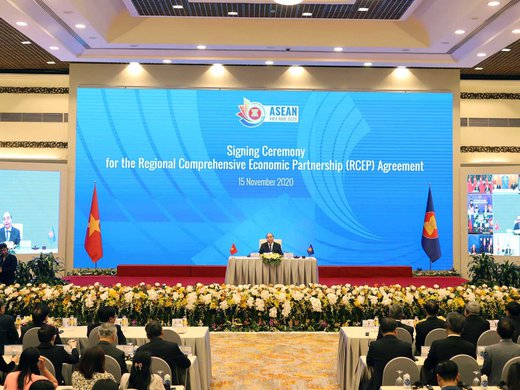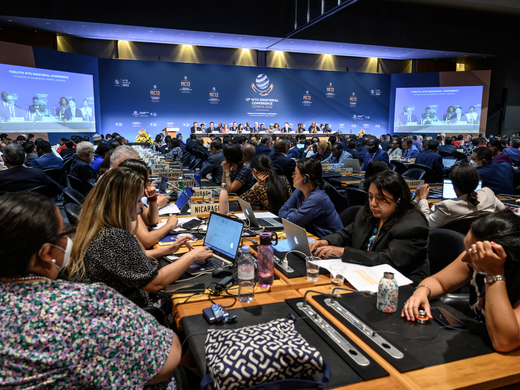On July 26, more than 80 members of the World Trade Organization (WTO) agreed to release a “stabilized text” of the Agreement on Electronic Commerce, which they’d been negotiating since 2017. Brazil, Colombia, El Salvador, Guatemala, Indonesia, Paraguay, Taiwan and Türkiye didn’t sign on to the release. Neither did the United States, surprisingly.
The agreement was hailed as “historic” and as a “rare opportunity to celebrate negotiating success” by Deborah Elms, who is head of trade policy at the Hinrich Foundation. She also wrote that it “should accelerate…growth” in digital trade, even if the agreement doesn’t include explicit market access commitments. This is because, she says, it provides “a common platform — perhaps soon a de facto global standard — for more than 80 countries to better insure regulatory consistency.”
For their part, a group of trade experts writing for the University of Adelaide’s Institute for International Trade praised the agreement as follows: “There can be no question that this deal is a standout success that bucks the recent global trends.” They added that “the new rules will reduce the cost and complexity of international commerce while also supporting trust and security for consumers.”
The European Commission, meanwhile, says that the agreement will “benefit both consumer and businesses and support digital transformation…by: facilitating cross-border electronic transactions, reducing barriers to digital trade, and promoting innovation in e-commerce.”
All that makes the WTO’s e-commerce agreement sound like a game changer. But a look under the hood reveals much less than meets the eye.
To begin with, the agreement must become legally binding on its signatories before it can go into effect. According to Devon Whittle, a trade expert based in Sydney, Australia, this can be achieved in one of two ways. One is to integrate the agreement within the WTO’s legal framework, which won’t be easy. The other is for the agreement to stand alone outside the WTO — meaning it would require its own separate dispute settlement mechanism.
And even if it becomes somehow binding at some point in the not-so-distant future, the agreement may not move the needle much in terms of fostering greater digital trade.
It’s true that the agreement, by locking in the moratorium on the imposition of customs duties on electronic transmissions for five years before a review takes place, would reduce the current uncertainty around the moratorium’s two-year cycle. Earlier this year, the WTO’s director-general, Ngozi Okonjo-Iweala, indicated that it is unlikely that the moratorium would be renewed at the next ministerial conference (MC) in 2026, as it has been at every MC since 1999.
Existing trade agreements or digital partnership agreements have followed a similar approach, and have little to show for it.
Businesses worldwide would welcome the moratorium’s extention to five years. However, it still leaves open the question as to how the agreement’s review process would operate with respect to maintaining the moratorium. Once the review process is complete, must the agreement’s signatories all agree to remove the prohibition on duties (otherwise, it continues applying), or must they agree to keep it (otherwise, it stops applying)? The former scenario is much more favourable to the moratorium’s continued existence (it only takes one country to vote against the prohibition’s removal) than the latter (it requires all the members to vote to keep the prohibition). Thankfully for businesses, the language found in the agreement’s article 11.5 suggests that the former scenario applies; the prohibition on duties continues to apply unless all members decide otherwise after the review process is complete.
The agreement encourages international regulatory cooperation in areas such as consumer protection, privacy protection, cybersecurity, generative AI and paperless trading (for example, electronic documents, electronic authentication and signatures, electronic payments, data exchange and customs procedures). But it doesn’t make it mandatory for the parties to cooperate and come up with common or mutually recognized standards and procedures. Instead, the agreement uses the language of persuasion: “shall endeavour,” “recognize,” “encourage,” “acknowledge.”
Existing trade agreements or digital partnership agreements have followed a similar approach, and have little to show for it. A good example is the Canada-United States-Mexico Agreement (CUSMA): four years after CUSMA entered into force, the partners have not yet agreed on any concrete proposals. They have not even set up the called-for forum for exchanging information and discussing regulatory-cooperation matters. And these are countries that are closely integrated with each other economically. So, we can imagine how difficult, if not impossible, regulatory cooperation would be under the WTO’s Agreement on Electronic Commerce.
Surprisingly, perhaps, unlike several existing bilateral and regional agreements, the WTO e-commerce agreement has no provision calling for the unfettered flow of data across borders. It offers only article 25, which states: “Nothing in this Agreement shall prevent a Party from adopting or maintaining measures on the protection of personal data and privacy, including with respect to cross-border data transfers, provided that the law of that Party provides for instruments enabling transfers under conditions of general application for the protection of the data transferred.”
In other words, restrictions on cross-border data transfers for protecting privacy or personal data are fine, as long as there are enabling instruments for transfers (for example, standard contractual clauses and certification mechanisms) and those are applied in a non-discriminatory manner.
Presumably, the Agreement on Electronic Commerce’s position on cross-border data flows reflects Chinese and American positions. From the start, China’s view was that cross-border data flows should comply with members’ national laws and regulations and that any measure to limit such flows is acceptable if a member claims it’s necessary for national security. This is the approach taken in the Regional Comprehensive Economic Partnership, which ultimately makes liberalizing provisions useless.
At the end of October 2023, the Office of the US Trade Representative indicated that the domestic regulation of data, privacy, artificial intelligence, online content and the like now took precedence over unhindered international digital trade and data flows — which the United States had previously strongly defended (including in the WTO’s negotiations on e-commerce). Ironically, the United States’ changed stance with respect to restrictions on cross-border data transfers and data localization requirements has had the effect of making agreement at the WTO possible; the United States’ new position was now aligned with China’s.
But even in cases where trade or digital agreements have the potential to limit the ability of governments to regulate data and the digital economy domestically, they have not prevented national regulation from impeding cross-border data flows between their member states. For instance, data localization measures have been increasing rather than decreasing in the last decade. They have also become more complex and fragmented, thereby making it more costly for firms in terms of compliance.
In conclusion, based on its language and the experience of exiting trade or digital agreements so far, the “stabilized” version of the WTO’s plurilateral Agreement on Electronic Commerce is no game changer. Yes, we should rejoice at the fact that 80-plus countries at the WTO managed to agree on an e-commerce text, but we should not ignore that this agreement was made possible precisely because it doesn’t require its parties, should they ever ratify it, to do much other than endeavour to cooperate on digital standards and regulations. The agreement’s only tangible benefit for digital trade is that it would make it difficult to remove the current WTO prohibition on imposing customs duties on electronic transmissions. In sum, the agreement reflects today’s ineffective rules of the game in governing international digital trade, nothing more.



